Latin American Ropeways
Improving accessibility and social inclusion
Jens Fiedler investigated function and meaning of ropeways. For Favas.net he elaborated his findings regarding Latin America, that he considers to be the nursery of social mature applications of ropeways. These ropeways can support sustainability and social inclusion, since in Latin America particularly these kind of cable cars not only brought about a change in the sense of transport, but also in socio-spatial terms. However, to understand these terms Jens after his introduction first explains some technical issues.
Introduction
A comprehensive and, above all, rapid turnaround in transport is urgently needed to achieve the environmental targets agreed in the Paris Climate Agreement. In addition, future generations should be left with liveable cities and a liveable world in general. A traffic turnaround has been discussed for more than 25 years and the topic has by no means lost its relevance. The transport sector was and still is not very sustainable. However, new solutions are still very car based, especially in North America. One only has to mention Elon Musk’s pointlessly inefficient idea of the Las Vegas Loop. On the other hand, there is a mode of transportation that has been proven and climate-friendly for several decades and moreover can support social inclusion due to improved accessibility. This means of transport is the ropeway. Ropeways can not only take tourists up a mountain but can also be used in an urban context. This is already the case in South America in particular. The most prominent example here is certainly La Paz, Bolivia, which has the largest urban ropeway network in the world. But also Bogotá, Manizales and Medellín in Colombia, as well as Rio de Janeiro (Brazil) and Mexico City rely on the ropeway as a means of public transport.
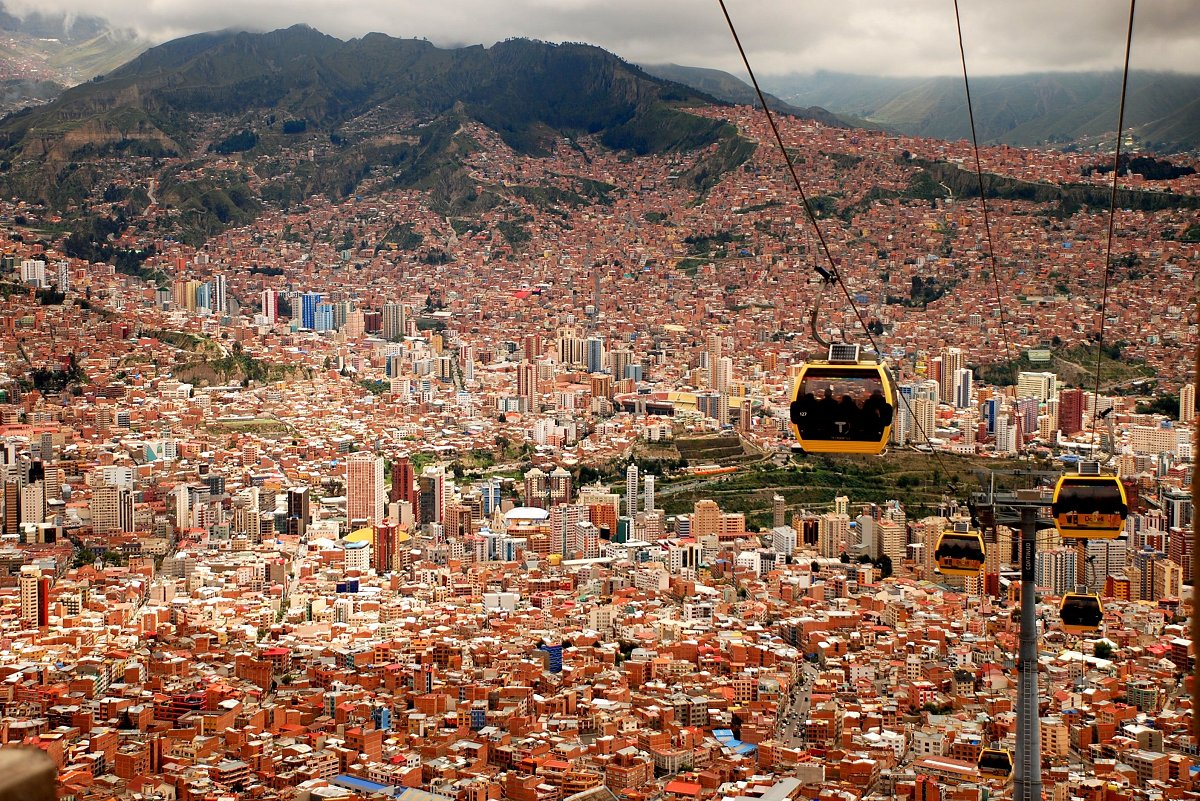
La Paz Teleférico
Technical issues
Important to note is that a ropeway system is not meant to compete with other transport modes in the city. It is intended as a supplement that will make the transport network more effective. Various concrete functions can be attributed to a ropeway. The most obvious function and at the same time the greatest advantage is bridging. They can float over obstacles such as rivers or valleys and are not tied to any road course. They can also extend existing lines, such as a metro / subway, which is more expensive to build. In the same context, they can also close gaps in the existing network by connecting two termini of other modes of transportation. Another function is to connect. For example, a park-and-ride lot outside the city could be connected to an industrial area or the city by cable car. An important function that any public transportation system should fulfil is to relieve congestion on existing infrastructure. For example, ropeways can float past traffic jams on the roads, possibly encouraging people to switch to them. Finally, the creation of new transportation networks is possible. The suburban area can be connected to the city if there is no public transport on this connection yet (Doppelmayr/Garaventa, pp 14-15). The ropeway stations can not only serve as a hub for mobility, but also as multifunctional spaces. They can include sport or cultural offers, authorities, and other public institutions. Such hybrid concepts can turn cable cars and their stations into public places in the city that are directly connected via the cabins (see our reference Kienbaum, L. (2020), p. 31 – for the rest of the text briefly referred to as Kienbaum – ditto for all following references).
In our table (below) characteristics like speed and capacity of the presented ropeway systems are shown. The aerial tram has the highest possible operating speed with 43 km/h and large cabins that can accommodate up to 200 passengers. Although that is significantly more than with a MDG or BDG system *), the aerial tram has a lower line capacity. A maximum of 2,800 passengers per direction per hour (ppdph) can be transported by the aerial tram. This is due to its inflexibility because there are only two cabins, that mostly cannot be operated independently. Gondolas, on the other hand, achieve higher line capacities despite their much smaller cabins because of their detachability and higher frequency. It is possible to take a gondola every twelve seconds (Alshalalfah, p.258). Because of their third rope TDG systems combine the benefits of the aerial tram and a gondola ropeway. Higher speeds and larger cabins are now feasible, resulting in higher overall capacity. However, this comes with a relatively high construction costs per kilometre.
| Aerial Tram | MDG | BDG | TDG *) | |
| Operating Speed (km/h) | Max. 43.2 | Max. 21.6 | Max. 21.6 | Max. 31.6 |
| Vehicle capacity | 20-200 | 4-15 | 4-15 | Max.35 |
| Line capacity (ppdph) | Max. 500-2,800 | Max. 3,600 | Max. 3,600 | Max. 6,000 |
| Investment cost/km (Million US$ | 15-25 | 5-10 | 10-20 | 15-25 |
Table: Characteristics of various ropeway systems (based on reference Alshalalfah).
In reality, aerial trams tend not to achieve the highest possible transport capacity because of their inflexibility. If boarding is delayed at one cabin, the whole operation is delayed (Alshalalfah, p.258).
*) Ropeway aerial tram type entails only two large cabins that always shuttle back and forth in opposite directions between two points and meeting halfway. At least one cable here serves as a track cable that does not move and is responsible for holding the cabin. The other type ropeway is the so-called gondola lift, which, in contrast to the aerial tram, travels permanently in a loop. MDGs (Monocable Detachable Gondolas) are characterised by smaller gondolas suspended from a single rope that simultaneously propels and suspends the gondola. BDGs (Bicable Detachable Gondolas) consist of two cables, one for suspension (the track cable) and one haulage rope. This allows larger spans between the support towers or stations. In this way, the advantages of a gondola system are combined with those of the ropeway aerial tram style, namely continuous transport with larger distances between the towers. Finally, there are systems with two support cables and one cable as a drive. These Tricable Detachable Gondola (TDG or 3S, for the German term Dreiseilumlaufbahn, three cable ropeway) can reach higher speeds and above all higher capacities in the gondola.
The case of La Paz
Usually, ropeways (sometimes referred to as aerial cable cars, or aerial tramways) work as a feeder for the local metro / subway or similar public transport / mass transit. However, one of the first cities that implemented a ropeway system as primary backbone of public transport is La Paz in Bolivia. (Martinez, p.21). La Paz, together with the city of El Alto, formerly part of La Paz, forms an agglomeration of 1.8 million people. About 1.7 million trips are made daily in the agglomeration, 350,000 of them between the two major cities (Martinez, p.5). However, because of its location in the Andes Mountains, there is the challenge of overcoming altitude within the metropolitan area. A full 400 meters of altitude difference lies between neighbouring La Paz and El Alto. El Alto has one of the strongest population growths in the world. It has doubled in the last two decades. Therefore, the city is very densely built, and streets are very narrow (Garsous, p.172). Roads were always congested and travel time to La Paz could be an hour during peak times. To avoid the traffic collapse, the first three ropeway lines were built in 2014 by the Austrian company Doppelmayr. This reduced the aforementioned commute time from one hour to ten minutes (Martinez, p.6); other studies estimate an average time saving of 22%, which corresponds to a net benefit of US$0.58 per commute. (Garsous, p.172).
Doppelmayr now operates ten ropeway lines spread throughout the city, two of which run to El Alto. It is an MDG system which transports more than 300,000 people a day on 33 km. The greatest difference in altitude covered is 666 m, the longest line is almost 4,900 m long. Most lines, differentiated by colour (see map), have a capacity of 3,000 ppdph (passengers per direction per hour), but some can carry 4,000 ppdph (Doppelmayr/Garaventa). The ropeways have a maximum operating speed of 20 km/h and an average speed of 19 km/h, so they are very efficient. They carry passengers over the city’s rooftops for 17 hours a day. However, with a capacity of ten people per cabin, they are quite small (Garsous, p.173). Despite reaching 200 million trips in 2018 (Antriebspunkt, 2018), the modal share of Mi Teleferico, the Spanish name of the network, remained low. In the team of Garsous’ small survey, the system only came to a share of 2%. Minibuses remained clearly the most popular mode of transport with 57% of trips made, ahead of walking with 19% (Garsous, p.175). There was mainly a substitution from public transport to the ropeway, while the switch from private cars remained low (Martinez, p.22). At least the lines of the first generation did not solve the congestion. There were still loud and jammed streets (Watts). Nevertheless, it would probably be even worse if the 300,000 daily ropeway users were to use the streets as well. With an average capacity of 3,000 pphpd distributed over ten lines and an operating time of 17 hours per day, more than one million people could ride the cable car every day. The actual use by 300,000 people daily corresponds to a utilisation of about 30%.

Socio-spatial terms
In Latin America in particular, however, the cable car not only brought about a change in transport, but also in socio-spatial terms. According to J.F. Kain, the seclusion of minorities is a direct reason for their poor economic situation. In Medellin in Colombia, a cable car network was integrated several years earlier than in La Paz. The new means of transport not only resulted in better accessibility for some parts of the population segregated by landscape alone, but according to research of Heinrichs and Bernet also led to an improved security situation for the residents along the new routes. With the ropeway, complementary investments were made for social and spatial change. Investments seven times the construction cost were made in the four years after construction to improve the area, the community and their economic situation, according to Goodship. Such investments can include social infrastructure such as social housing, schools and more, but also mean supporting small enterprises (Brand and Dávila). Evidence shows that in close proximity to the ropeway the number of shops, bars, and small businesses has increased. It helped to normalize the informal professional sector. At the same time no changes can be observed in this regard in more far away areas (Brand and Dávila, p. 65). Because of the ropeway, Medellin was elevated from a once violent city to some kind of best practice. Stories of gang violence seem to be no more and especially women feel safer and more comfortable traveling with the ropeway. This is because it is not as crowded as the metro or conventional busses and the risk of being harassed is lower (Heinrichs and Bernet, p. 65). In contrast, Matsuyuki et al. (pp. 3277-3278) found no significant evidence that crime rates declined more in the ropeway´s vicinity than in areas farther away. However, since 2003 the overall number of crimes dropped throughout the city. Additionally, the local society improved in the sense that inhabitants felt more pride of their neighbourhood. The ropeway created better visibility of the socially stigmatized. Another positive side effect is the improvement of air quality in the city (Dávila and Daste, p. 4).
Similar hopes were also expressed in La Paz. In addition to relieving the roads, it was hoped to close not only the geographical but also the economic gap between the poorer inhabitants of El Alto and the middle class in La Paz (Watts). And indeed, increased connectivity has led to more employment opportunities as the labour market is more accessible, which is especially beneficial for residents of El Alto, as La Paz offers the main economic and recreational activities (Martinez, p.22).
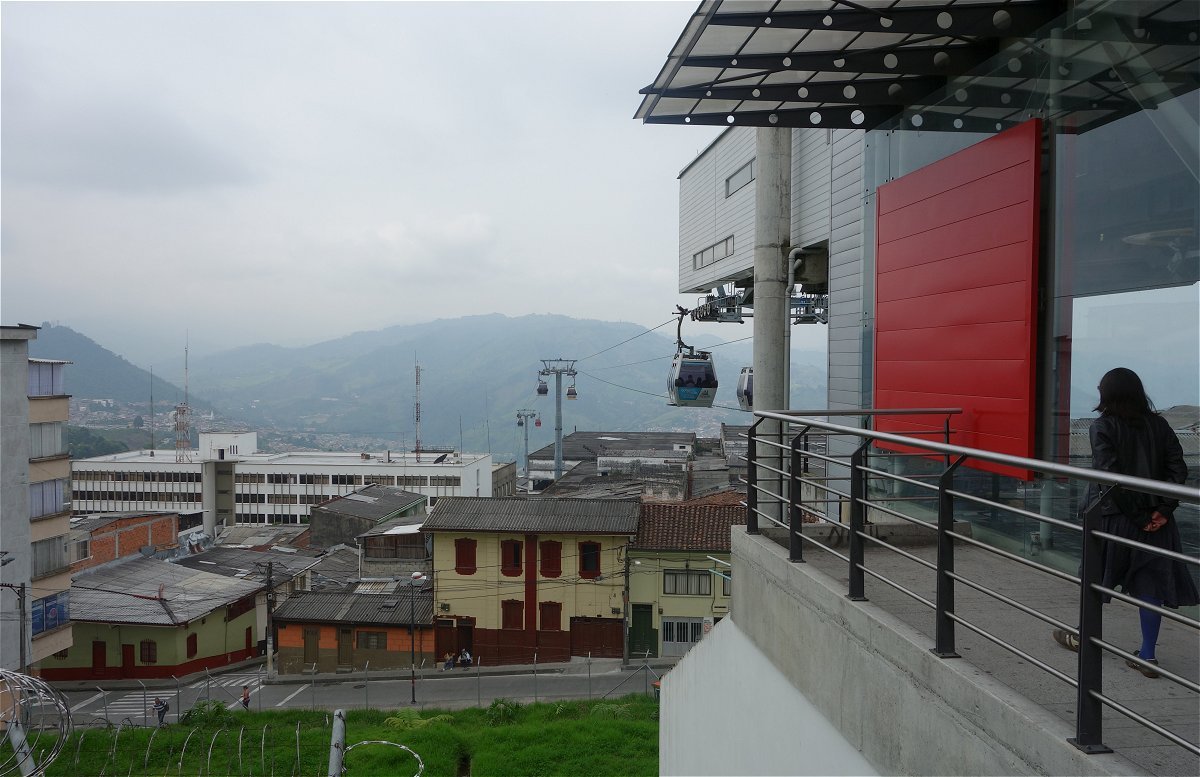
Manizales, Fundadores station
Conclusions
Urban ropeways are getting more popular for planners and politicians. Latin America shows how a cable car system can be implemented in the city. Manizales, Medellin, La Paz, Mexico City for instance rely on it as the backbone of their public transport. There it helped to avoid the traffic collapse, at least temporarily, but especially helped to reduce socio-spatial segregation. For instance, a better connectivity of neighbourhoods leads to a better opportunity on the labour market. However, it is important to note that a ropeway network alone will not improve the social situation. Complementary actions need to be taken and the ropeway needs to be embedded in the city´s social and spatial conditions.
Note on ropeway’s social effect
Professor Julio D. Dávila (from Bogotà, but now working at University College London), referred in interviews to an additional possible effect of ropeways. He pointed in this regard to the socio-spatial location of (once segregated) citizens: “Connecting their neighbourhoods to the rest of the city by the ropeway was a confirmation that they exist, that they have the right to live there.” (Dutch newspaper Parool, March 8, 2022). Apart from improved accessibility this seems an important additional argument that justifies the ‘social effect’ of this kind of public transport.
In another interview Dávila pointed to specific character of the ropeway-project in Medellín, hence, its role for the (once segregated) communities: “Medellín’s system sends a message to these communities that the city values them, it’s a way of inverting the pyramid”. (The Oxford Society for International Development, May 3, 2020).
References
Alshalalfah, B.; Shalaby, A.; Dale, S.; Othman, F.M.Y. (2012) “Aerial ropeway transportation systems in the urban environment: State of the art”. Journal of Transportation Engineering. 138 (3), 253-262.
Antriebspunkt (2018) “Urbane Mobilität mit der Seilbahn in La Paz – Mit dem größten Seilbahnnetz der Welt gegen den Verkehrskollaps“. https://www.antriebspunkt.de/urbane-mobilitaet/seilbahn-la-paz/. (23.01.2022).
BMDV (2021) “Urbane Seilbahnen – klimafreundlich, preiswert, zuverlässig” https://www.bmvi.de/SharedDocs/DE/Artikel/G/urbane-seilbahnen.html. (24.01.2022)
Brand, P.; Dávila, J.D. (2011) Mobility innovation at the urban margins: Medellín’s Metrocables. City 15 (6), 647–661.
Dávila, J.D., Daste, D. (2012) Medellin’s aerial cable cars: Social inclusion and reduced emissions. UNEP-IPSRM Cities, Decoupling and Urban Infrastructure.
Doppelmayr/Garaventa (s.d.a) “Urban-Brochure: The next level of mobility. Ropeways as a means of urban transport”. https://www.doppelmayr.com/applications/urban/urban-brochure/. (23.01.2022).
Doppelmayr/Garaventa (s.d.b) “Colors of La Paz – The world´s largest urban ropeway network”. https://lapaz.doppelmayr.com/en/. (23.01.2022).
Garsous, G.; Suárez-Alemán, A.; Serebrisky, T. (2019) “Cable cars in urban transport: Travel time savings from La Paz-El Alto (Bolivia)”. Transport Policy. 75, 171-182.
Goodship, P. (2015) “The impact of an urban cable car transport system on the spatial configuration of an informal settlement”. Proceedings of the 10th International Space Syntax Symposium.
Heinrichs, D.; Bernet, J.S. (2014) “Public transport and accessibility in informal settlements: Aerial cable cars in Medellín, Colombia”. Transportation Research Procedia. 4, 55-67.
Kain, J.F. (1968) „Housing segregation, negro employment, and metropolitan decentralization”. The Quarterly Journal of Economics. 82 (2), 175-197.
Kienbaum, L. (2020) “Urbane Seilbahnen als dynamische Elemente in Stadt und Architektur“. In: Schumacher, M.; Vogt, M.-M.; Cordón Krumme, L.A. (Eds.) Architektur in Bewegung – Neue dynamische Komponenten und Bauteile. Basel: Birkhäuser, pp. 30-31.
Martinez, S.; Sanchez, R.; Yañez, P. (2018) “Getting a Lift: The Impact of Aerial Cable Cars in La Paz, Bolivia”. IDB Working Paper Series (IDB-WP-00956), Washington DC.
Matsuyuki, M.; Okami, S.; Nakamura, F.; Sarmiento-Ordosgoitia, I. (2020) Impact of aerial cable car in low-income area in Medellín, Colombia. Transportation Research Procedia. 48, 3264-3282.
Watts, J. (2016) “Subway in the sky: has La Paz’s cable car made a real difference to the city?”. The Guardian. https://www.theguardian.com/cities/2016/feb/10/la-paz-cable-difference-city-subway-sky. (23.01.2022).
See also:
Prof. Julio Dávila: The Transformative Power of the Cable Car in Medellín, Colombia, interview by Flora Davies in The Oxford Society for International Development (OxSID), May 3, 2020.
Medellín bewijst dat ov-kabelbaan veel meer is dan toeristenattractie, interview by Tom Kieft in newspaper Het Parool, March 8, 2020.
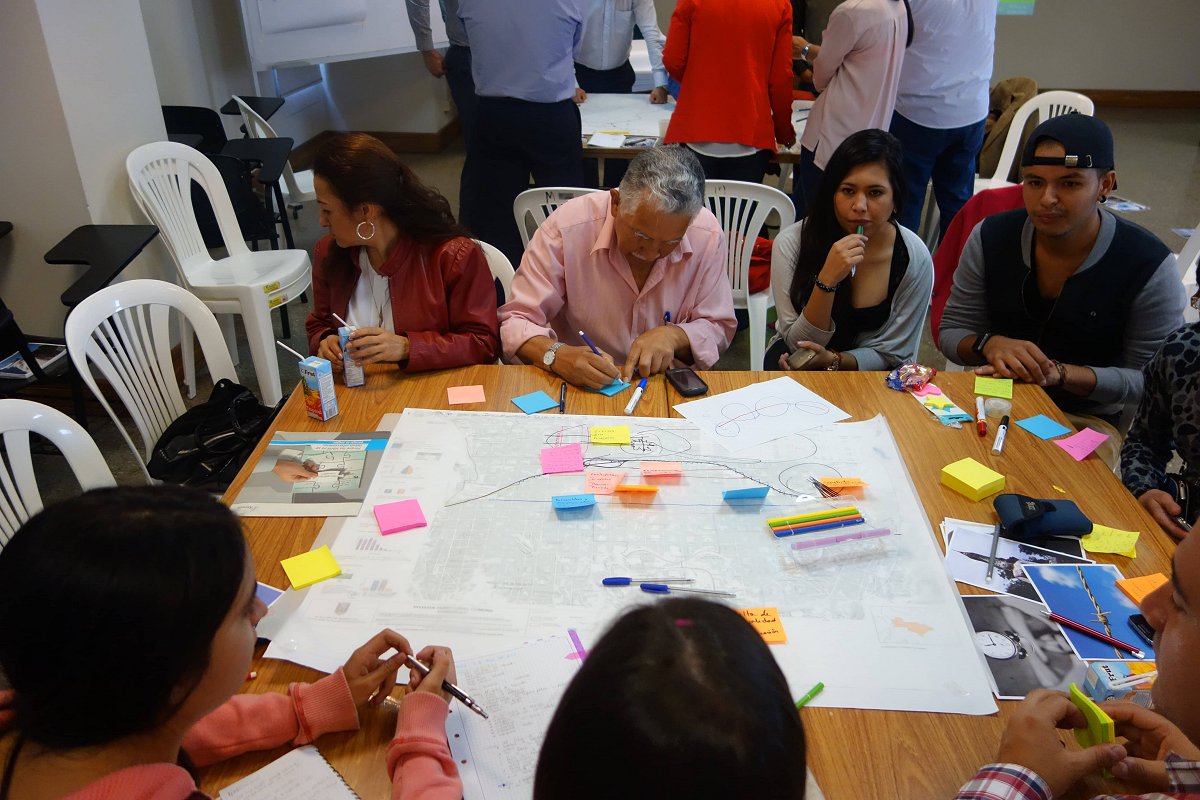
Workshop Manizales
May 2015 Favas.net joined a team that supervised a workshop (Fava-method style) in Manizales for civil servants of the city to address mobility-related spatial and social issues. The team was led by the urban planning office Urbanos. The participants were challenged to explore the future of the central city. And so several networks in Manizales were examined. The ropeway station Fundadores was assigned an important position in these explorations.
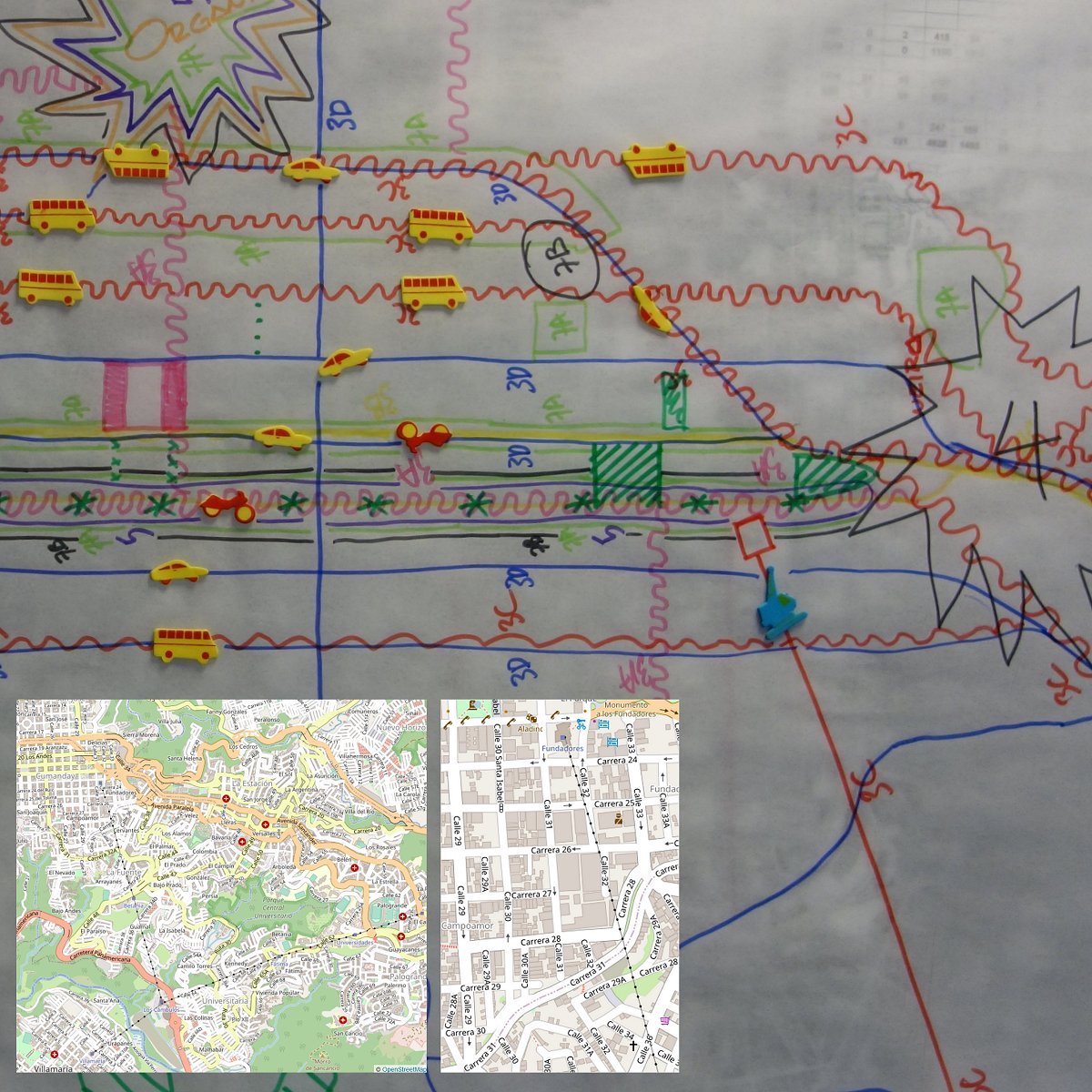
Urbanos office directed by Camila Pinzón Cortes and Pepijn Verpaalen. Its Spanish name means ‘everybody living in urban areas’, representing a human-centered approach of neighborhoods, towns, cities and regions. The workshop was assigned by Municipio de Manizales.
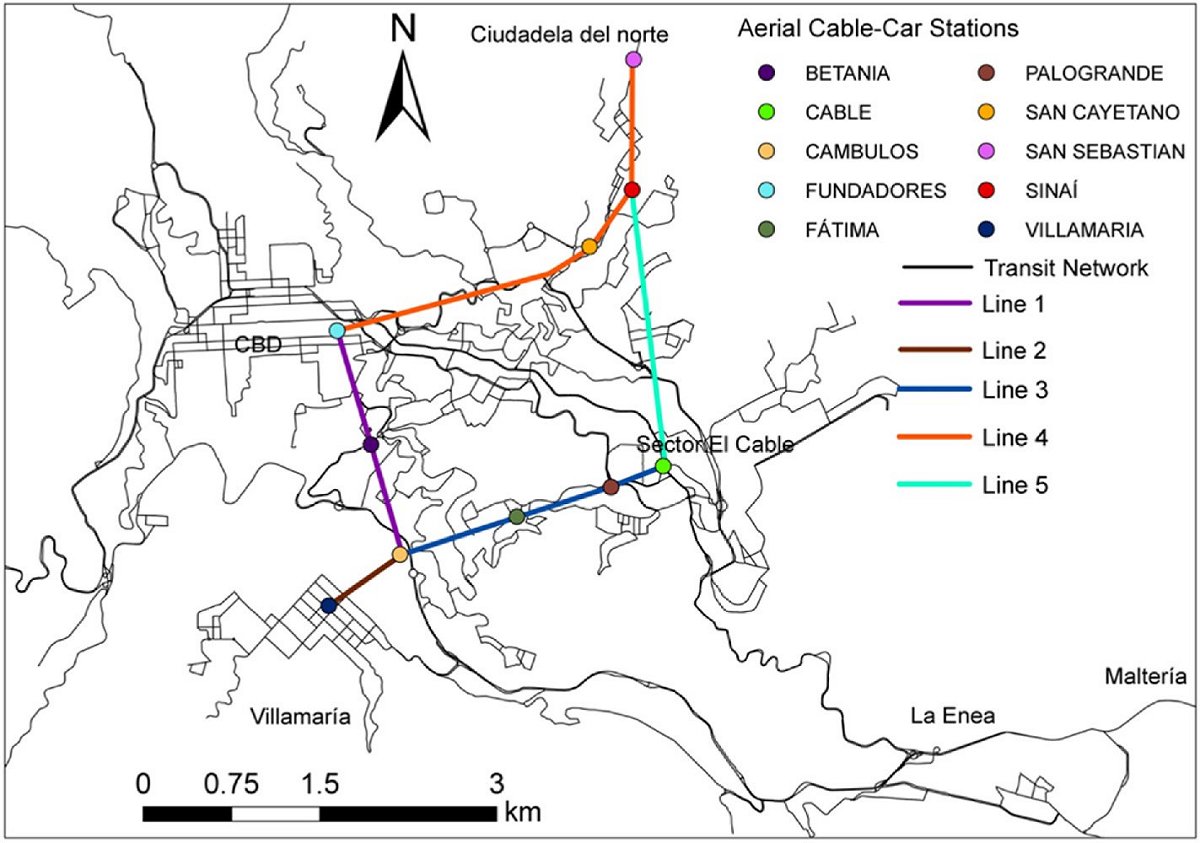
Acknowledgements
Project: Jens Fiedler
Editing: Favas.net (Rob van der Bijl)
Image La Paz Teleférico: Snowscat
All other images: Favas.net (Manizales, May 2015)
Map La Paz, Mi Teleférico: copyright according CC BY-SA 3.0 – https://creativecommons.org/licenses/by-sa/3.0/
Map Manizales network: courtesy Municipio de Manizales
Map section Manizales: OpenStreetMap
Data and material used in this project by Jens Fiedler are obtained by means of desk research. On-site survey of Favas.net in Manizales, Colombia (May, 2015) served as additional reference.
The project and underlying research by Jens Fiedler is based on the Course ‘Mobility & Space’, supervised by professor Rob van der Bijl, Ghent University (Belgium), 2021-2022.

Manizales, Fundadores station

